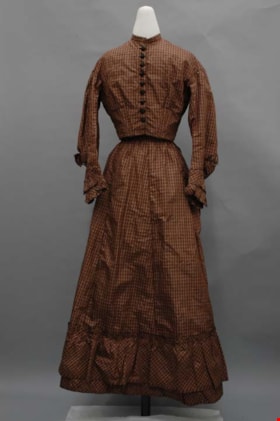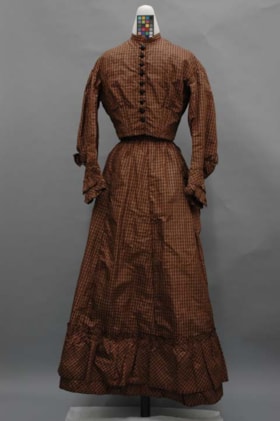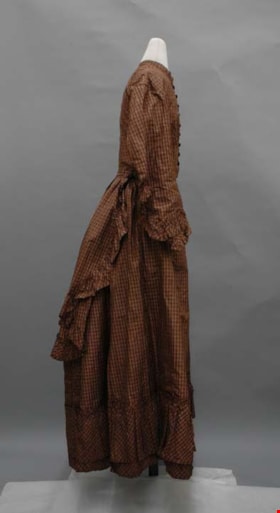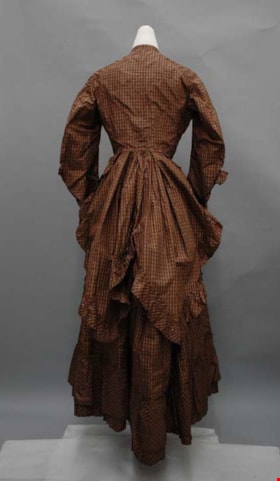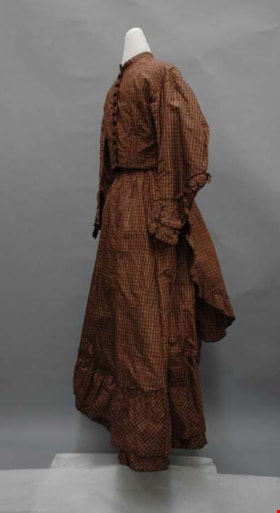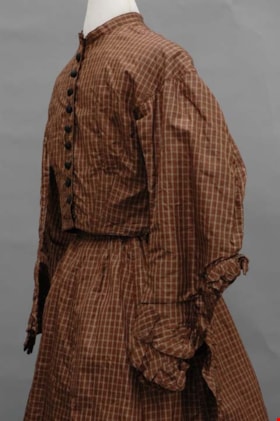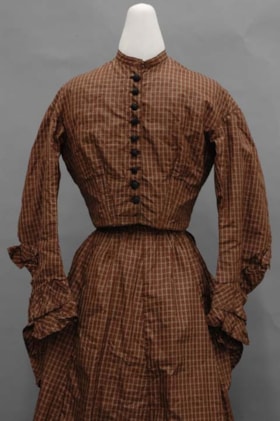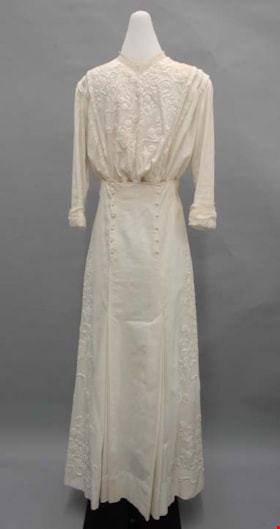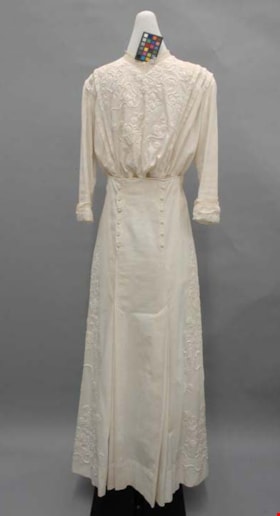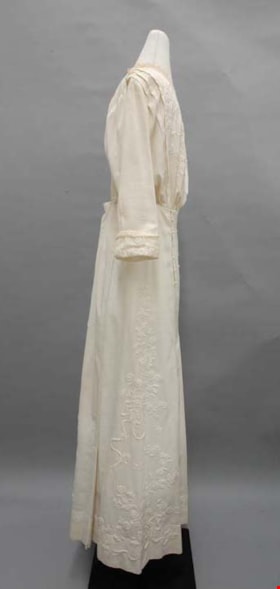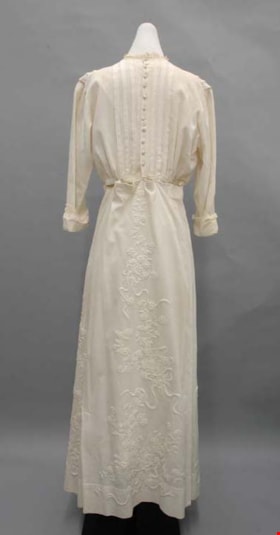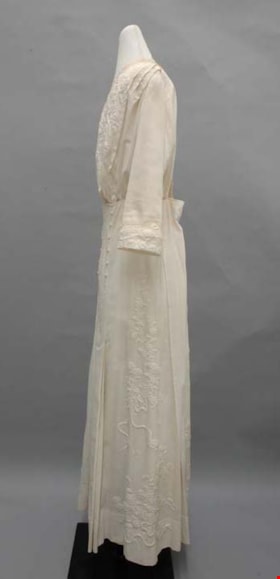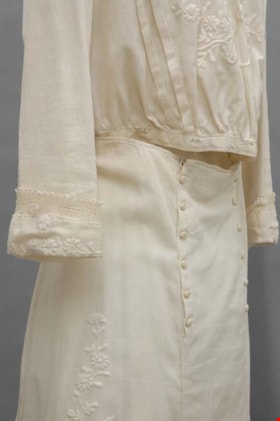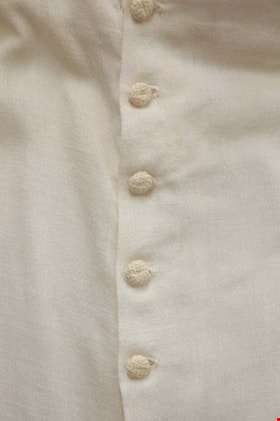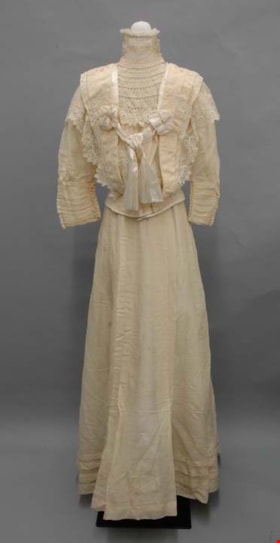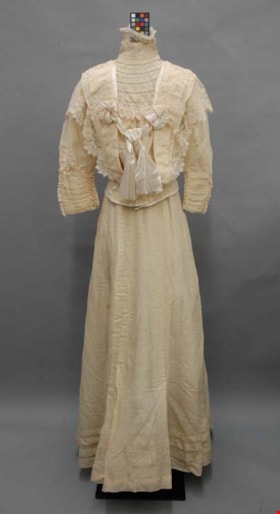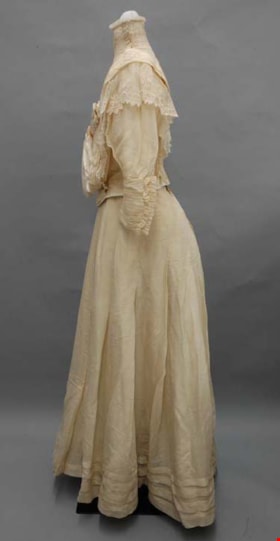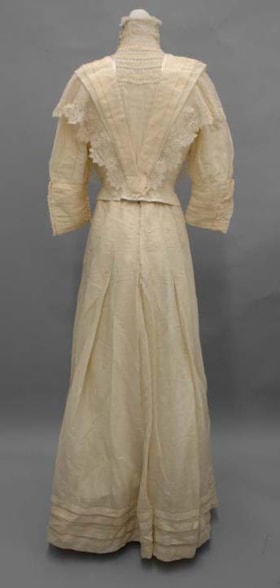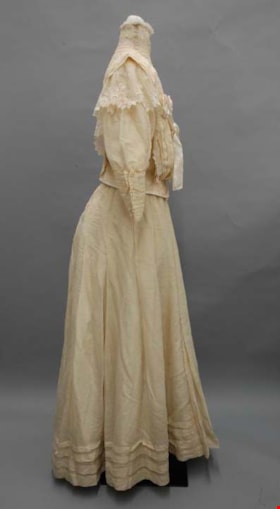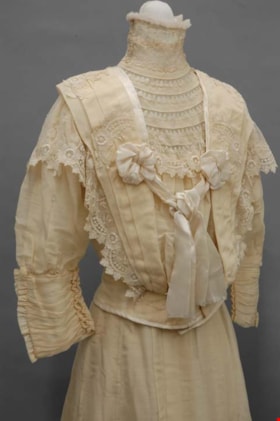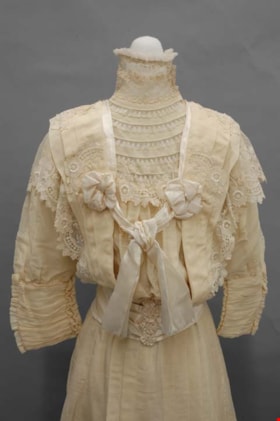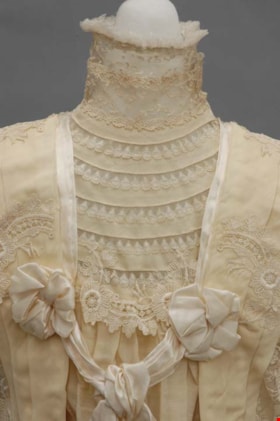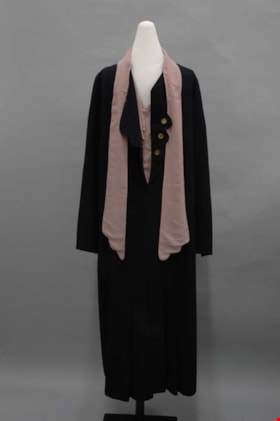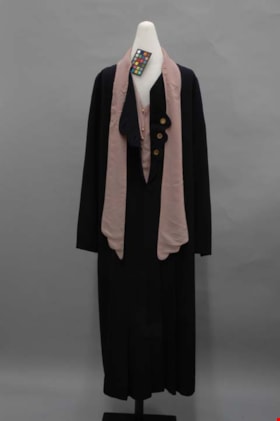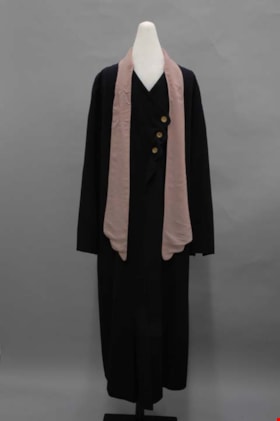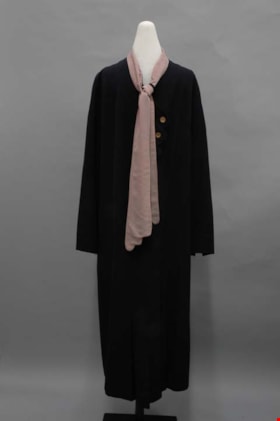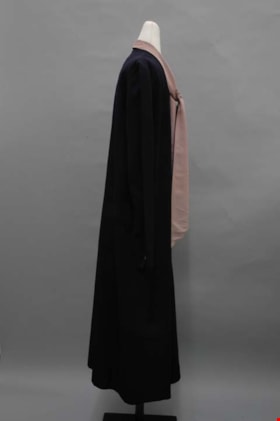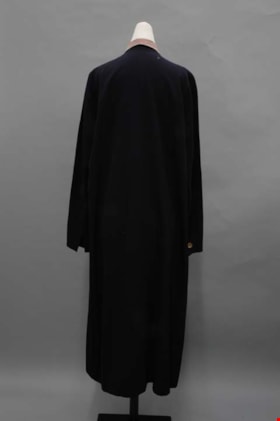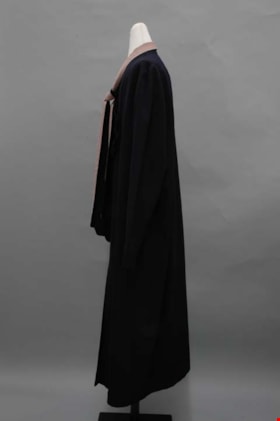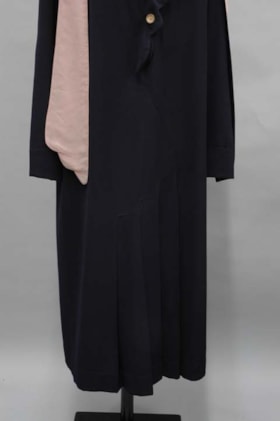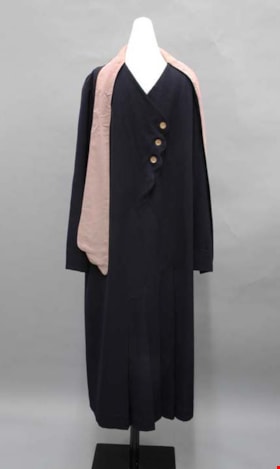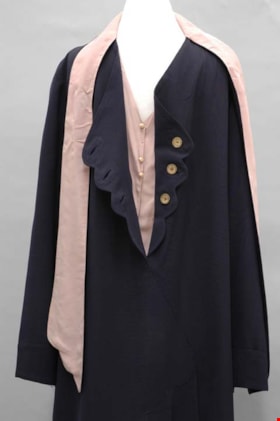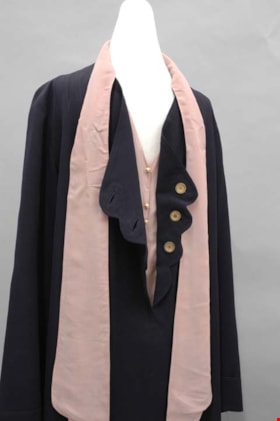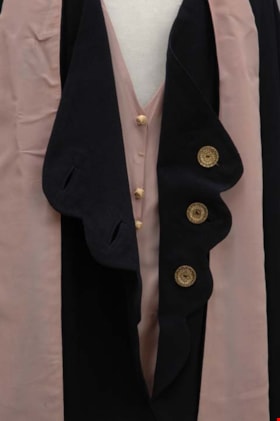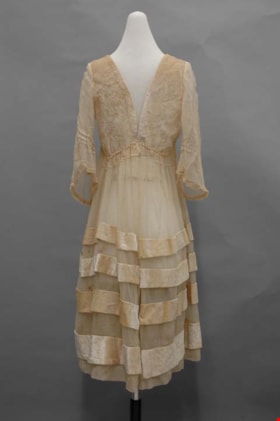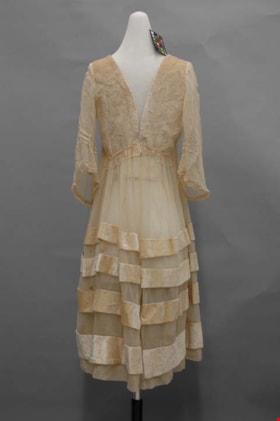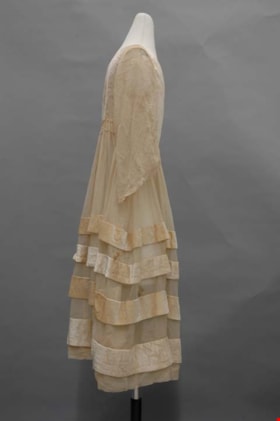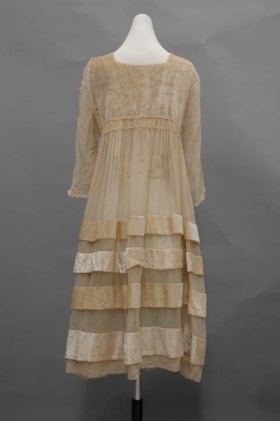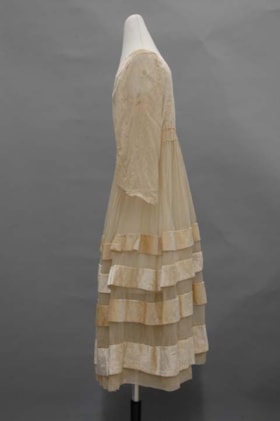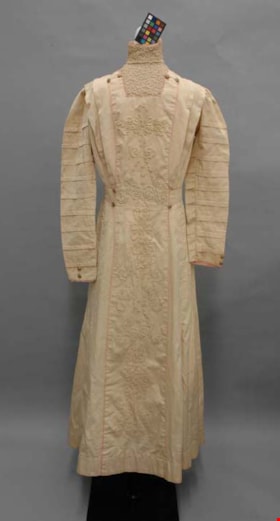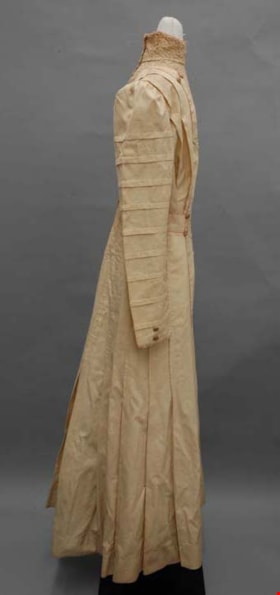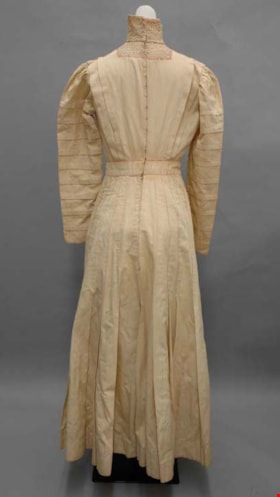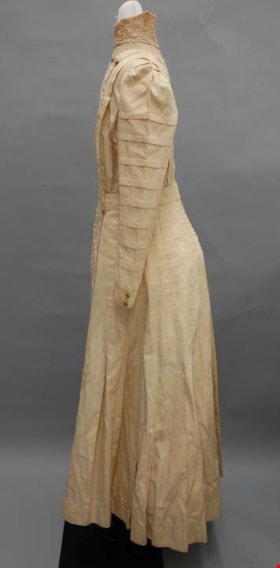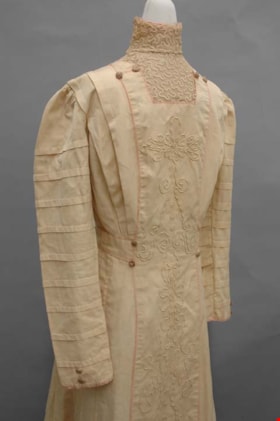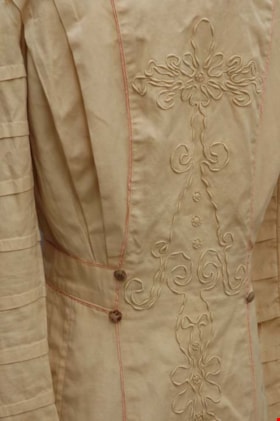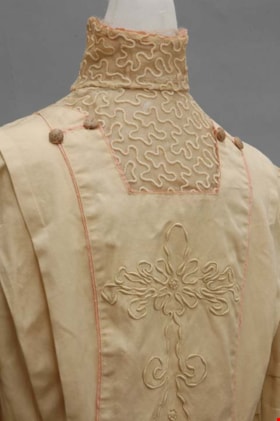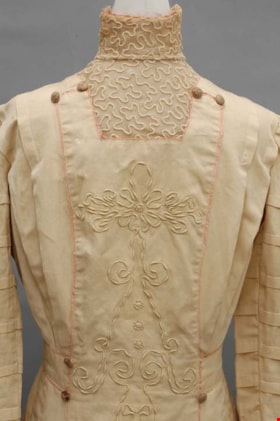Narrow Results By
bodice and skirt
https://search.heritageburnaby.ca/link/museumartifact3347
- Repository
- Burnaby Village Museum
- Accession Code
- BV989.38.1
- Description
- Bodice and skirt, c.1864-1870. Brown silk taffeta with white checked pattern. Small standing collar, sloping shoulders, long sleeves with ruffle, black buttons down centre front, polonaise attachment at the back. Skirt has elastic waistband, and equal volume all around. Ruffle trim around hem. Hand sewn.
- Object History
- The dress is reported to have been worn by the donor's aunt, Sarah Ellen Thompson, who was born in 1872 which would suggest this is an 1880s bustle dress. However, the short straight waist, sloping shoulders, wide sleeves, piped seams and light boning placed in the darts suggest an earlier date of 1860s or early 1870s. The polonaise is tacked on to the back, instead of a continuation of the bodice, and the skirt does not look like the late bustle period. Likely made in early bustle period of the late 1860s-early 1870s. Elsewhere in the file, it is reported the donor got the dress from a friend, not from her aunt.
- Subjects
- Clothing
- Clothing - Costumes
Images
wedding dress
https://search.heritageburnaby.ca/link/museumartifact4503
- Repository
- Burnaby Village Museum
- Accession Code
- BV988.71.1
- Description
- Wedding dress, c.1909-1910. White cotton crepe with hand embroidery. Short bodice with pin tucks, slight pouf, and three quarter sleeves. Pleated ankle length column skirt. The bodice has a small lace edged V neck, and three pin tucks on each shoulder. Two of the pin tucks angle inwards and continue to the waistline. Between the tucks the bodice is covered with hand worked floral and ribbon themed embroidery. It is gathered at the waistband, creating a slight puff reminiscent of the recently out of fashion pouter pigeon bodice. The back of the bodice has three vertical pin tucks that extend from the shoulder to the waistband on either side of the centre back button closure, with thread covered buttons. There is a slight gather between the pin tucks and side back seams, from the panel under each arm. The sleeves are three quarters in length. They have turned up cuffs topped with embroidery and edged with the same lace as seen on the collar. The skirt has a sailor front opening with six thread covered buttons on either side of a centre front panel. Just past hip level, there are two accordion pleats on either side of the panel. There is a gore on each side and one on the back that flare out slightly; each has the floral and ribbon embroidery. On the back gore, there is a pleat on either side at calf level. The hem is ankle length.
- Object History
- From donor: "This was the wedding dress of my sister-in-law's mother, worn about 1905. They came from Maine. Made of cotton, hand embroidery, a typical "country-type" wedding gown of the period. It was given to me by my sister-in-law and I am only too glad to have it find such a welcoming spot in B.C.!"
- Subjects
- Clothing
- Clothing - Costumes
Images
wedding dress
https://search.heritageburnaby.ca/link/museumartifact6267
- Repository
- Burnaby Village Museum
- Accession Code
- BV985.18.1
- Description
- Wedding dress, c.1907. Converted to day dress. Cream and white pouter pigeon bodice with lace and high collar. Full skirt and separate cumberbund. The shape of this dress is exemplary of the Edwardian pouter pigeon front, with a tiny waist to match. In museum records, there is a copy of the original wedding photo; on the back is written "shows dress before alteration to current state as day dress." The only readily noticeable differences are the absences of lace trim in the cuff and on the china silk bodice rosettes.
- Object History
- Made by Pattie Adelina Pearson, for her marriage to Charles James Mitchell in Gravesend, Kent, England on September 26, 1907. After, they travelled immediately to Canada, living in the provinces of Saskatchewan and Alberta, her daughter and son being born in the latter province. Pattie moved to Vancouver in 1918, where with the exception of the period when she lived in Victoria, she lived until her death in October 1981 at the age of 101 years. She would have been 27 years old when she wore the dress.
- Subjects
- Clothing
- Clothing - Costumes
Images
dress
https://search.heritageburnaby.ca/link/museumartifact19429
- Repository
- Burnaby Village Museum
- Accession Code
- HV977.37.81
- Description
- Dress, c. 1921-1925. Blue wool crepe dress without shaping. A pink scarf is attached to the collar, and there is a false undershirt. This dress is in the typical straight shape and mid-calf length of the first half of the 1920s. The subtle motif of three scallops in the skirt, lapel, ties, and cuffs is typical of the period's art deco design. The only shaping in the garment comes from tiny darts in the shoulders; a few pleats in the centre front as well as the loose fit of the garment allows the wearer to walk with ease. The collar is low and rolled, with pink silk forming the public side. The underside is of the same fabric as the dress. The collar extends on either side in long strips that can be used as a tie or scarf. The ties end in the scalloped pattern of three bumps. Lapels extend on the bodice to just below the bust area, with three gold metallic buttons on the left side. Under the lapel opening is a false undershirt in the same pink silk as the collar. It closes with snaps, under false ivory coloured buttons with a pinwheel design. About two inches below the spot where the lapels meet, there are also belt loops on either side of the dress to indicate a dropped waist, although there is no waist shaping. The belt is not present. Where the lapels come together, the line of the right lapel continues downward diagonally to the left front. It then returns to the centre in a scalloped diagonal pattern, and at each scallop a new pleat extends into the skirt. The sleeves are plain except for the cuffs, which repeat the scalloped pattern of the lapels and skirt. There is one gold metallic closure on each cuff. The skirt ends with a false hem, which is hand sewn. There are quite a few hand sewn finishes to keep the dress in place, especially with the false undershirt, but it is mainly machine sewn. The seams are finished with a serger.
- Object History
- From the family home of Thomas Seaborn McNair and Mary Vida (nee McMillan) McNair who lived on West 33rd Avenue in Vancouver. Thomas McNair ran Edwards, McNair and Russell, an established estate agent business.
- Subjects
- Clothing
- Clothing - Costumes
Images
jacket; dress
https://search.heritageburnaby.ca/link/museumartifact27062
- Repository
- Burnaby Village Museum
- Accession Code
- HV974.69.58
- Description
- Jacket; cream velvet and crepe. Looks like a dress from the 1910s to 1920s period that was later altered.
- Subjects
- Clothing
- Clothing - Costumes
Images
wedding dress
https://search.heritageburnaby.ca/link/museumartifact30795
- Repository
- Burnaby Village Museum
- Accession Code
- HV972.5.5
- Description
- Wedding dress or perhaps a regular dress once worn as a wedding dress, c.1910. Made from a heavyweight beige cotton. Embroidered net collar and yoke, and embroidered front panel. Princess seams and pin tucks form a flared, pleated skirt. Long sleeves, and pink edging on some seams. The fabric is a heavy, somewhat glossy cotton that makes the dress seem more like an item to be for everyday activities instead of as a wedding dress. Its silhouette is distinctive of the late Edwardian period, with its higher waist, close natural shaping, and somewhat flared ankle length skirt. In the bodice, two pleats on each side front create fullness. The collar and yoke are made of netting, lined with white silk, edged with pink ribbon, and embroidered in an undulating pattern of lines. There are two small brown buttons (previously covered in pink fabric) on either side of the net yoke. Two pin tucks run the length of either side of the back bodice. The sleeves are full length, with gathered caps and nine 1cm pin tucks down the length of each. There are two false previously pink buttons on each cuff, which are also edged in pink. A two inch waistband extends from the centre front panel to the back. There is a previously pink button on each front corner, and the whole band is edged in ribbon. The top left button is missing. It has a pink lining on the inside. The skirt is made up of six gores, not including the centre front panel. The left and right side of the skirt each have eight pleats, released halfway down with pin tucks. On the centre back, a pin tuck on either side of the closure released a large inverted box pleat. A false hem is hand sewn at the bottom, and machine sewn at its top. The dress closes with hooks and eyes along the centre back, from the top of the collar to a third of the way down the skirt. On the centre front, there is a panel that extends from the shoulders to the hem, using princess seaming. It is edged along its seams with pink ribbon. It is covered in in a hand-applied ribbon of couched thread, as well as some embroidered french knot flowers down the centre front line. The dress is mainly machine sewn. Seams are finished by whip-stitching the seam allowances together when the selvedge is not used.
- Subjects
- Clothing
- Clothing - Costumes
